In a short 2004 thread about the inspirations for Albion's Tritonia sword, Eric McHugh wrote this:
It is interesting to note that Ewart's perception of this pommel type (R) may be the result of lack of information sharing. While I was in Sweden with Peter, we found three swords with a spherical pommel. What reinforces this idea of "lack of information sharing" was the fact that the people who managed the collection had little knowledge of the swords in question. We found this very cool little type XII with a spherical pommel. Peter and I nearly had a heart attack when we climbed on top of a ladder to look at the top shelf to find the sister sword to Tritonia. Along side it was a another sword from the 15th-16th Century (I think) that had a spherical pommel too. So that was three on one shelf. Peter can confirm this (because my memory is failing me) but I believe there was a tang and pommel (with grip) that had a spherical pommel. In any event, that is at least 4 sword within 40km of one another. This would cause one to believe that these spherical pommels were a scandinavian thing, but for whatever reason, the collections that have these sword don't share information about them. Now, don't get me wrong, they are not being territorial about it...after all they let me into the back area Happy But sometimes the academic priorities of an organization dictate that other ancient objects will be researched while others sit in storage.
So, I don't think this is as rare of a type as previously thought.
That was the beginning and end of that subject, but I'm intrigued. Is anybody out there willing and able to tell us more about what that 15th/16th c. sword with spherical pommel looks like? Blade type? Broad? Narrow? Hand-and-a-half? Grip shape? I'd really love to know more about this weapon and its cousins. I especially like the idea of a Svante-like sword with a Type R pommel and filed peen block, long tapered grip and a ribbon-like horizontally recurved cross. Would that be within historical bounds for Northern Europe ca. 1500? I can't say for sure, but it certainly wouldn't be too far out. There's a huge variety in artwork of the period, but I haven't seen anything exactly like that.
Hi Sean!
I dont know witch sword Eric talks about, but here is some links to pics and my old topic,
some of them have ball pommel.
from Historiska Museet
http://mis.historiska.se/mis/sok/include_image_exp.asp?uid=328115
http://mis.historiska.se/mis/sok/bild.asp?uid=328115
http://mis.historiska.se/mis/sok/include_image_exp.asp?uid=48103
http://mis.historiska.se/mis/sok/bild.asp?uid=48082 8-side'd pommel
i will see if i can fix those links in there tomorrow.
http://www.myArmoury.com/talk/viewtopic.php?p=49074
Allways something! :)
I dont know witch sword Eric talks about, but here is some links to pics and my old topic,
some of them have ball pommel.
from Historiska Museet
http://mis.historiska.se/mis/sok/include_image_exp.asp?uid=328115
http://mis.historiska.se/mis/sok/bild.asp?uid=328115
http://mis.historiska.se/mis/sok/include_image_exp.asp?uid=48103
http://mis.historiska.se/mis/sok/bild.asp?uid=48082 8-side'd pommel
i will see if i can fix those links in there tomorrow.
http://www.myArmoury.com/talk/viewtopic.php?p=49074
Allways something! :)
Fantastic information! Thanks, Patrik!
Updating this ancient thread, and expanding it to a general discussion of the pommel type:
Many examples here: http://www.myArmoury.com/talk/viewtopic.18698.html
Weapons of Warre lists a Type R pommel/hilt in concretion among the Mary Rose artifacts. The text compares it to a river find of a similar sword in the collections of the Royal Armouries. The RA kindly supplied a photo of that weapon (can't show it here, unfortunately). It's a very short Type XVIII with a downturned cross with escussion and a slightly flattened pommel of the exact type shown on some of those Swedish swords (no foot). Of course, many basket-hilt swords of the Mary Rose period have hollow, vertically-ribbed spherical pommels, the remains of which are found among the MR artifacts.
So, not even counting all of the relatively small, decorated variants of R used on rapiers and later longswords and bastard swords through the late 16th c., this "pure" massive, plain spherical type persisted through early 16th c., at least.
The wonderful new(ish) book Medieval Swords of Southeastern Europe shows at least one medieval sword with a pommel of this type. Photo and notes below.
AVB Norman has extensive notes on the later forms of this pommel (last images below).
 Attachment: 93.58 KB
Attachment: 93.58 KB

 Attachment: 87.06 KB
Attachment: 87.06 KB

 Attachment: 202.51 KB
Attachment: 202.51 KB
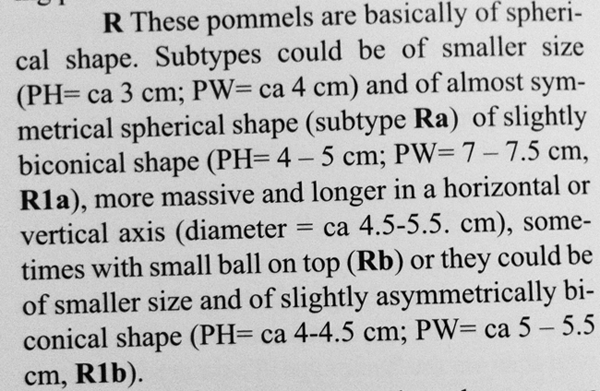
 Attachment: 215.28 KB
Attachment: 215.28 KB
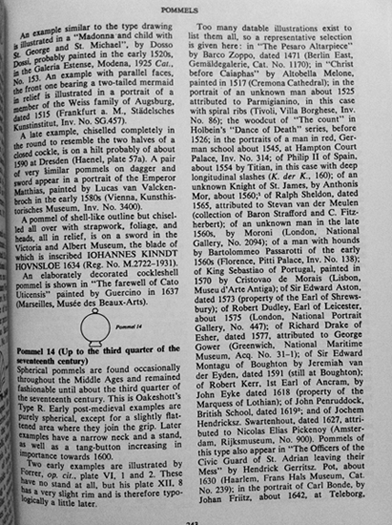
 Attachment: 194.95 KB
Attachment: 194.95 KB
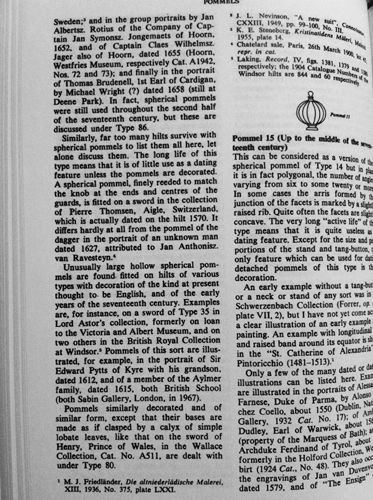
Many examples here: http://www.myArmoury.com/talk/viewtopic.18698.html
Weapons of Warre lists a Type R pommel/hilt in concretion among the Mary Rose artifacts. The text compares it to a river find of a similar sword in the collections of the Royal Armouries. The RA kindly supplied a photo of that weapon (can't show it here, unfortunately). It's a very short Type XVIII with a downturned cross with escussion and a slightly flattened pommel of the exact type shown on some of those Swedish swords (no foot). Of course, many basket-hilt swords of the Mary Rose period have hollow, vertically-ribbed spherical pommels, the remains of which are found among the MR artifacts.
So, not even counting all of the relatively small, decorated variants of R used on rapiers and later longswords and bastard swords through the late 16th c., this "pure" massive, plain spherical type persisted through early 16th c., at least.
The wonderful new(ish) book Medieval Swords of Southeastern Europe shows at least one medieval sword with a pommel of this type. Photo and notes below.
AVB Norman has extensive notes on the later forms of this pommel (last images below).





I've made a couple of these in recent years, using the Alchem 1.75" pommels as the "blank". One is footed, the other is not.
 Attachment: 190.2 KB
Attachment: 190.2 KB
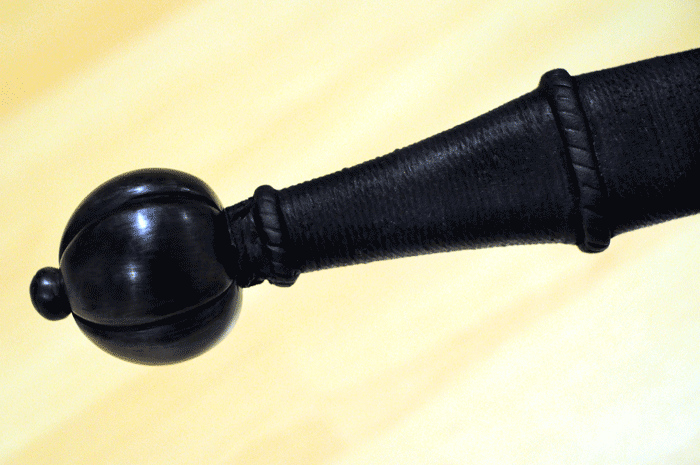
 Attachment: 188.54 KB
Attachment: 188.54 KB
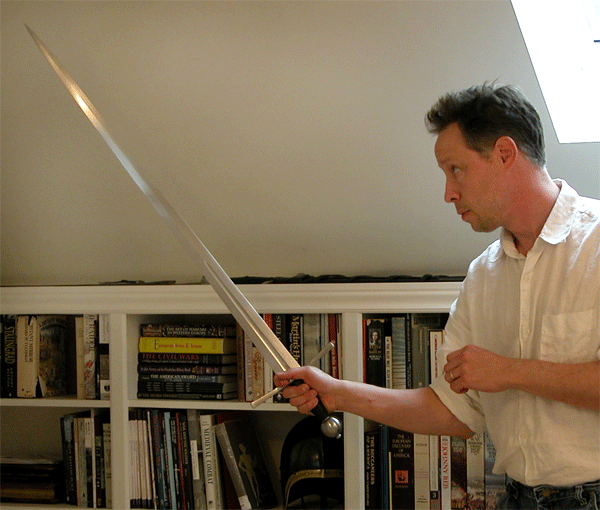
 Attachment: 168.42 KB
Attachment: 168.42 KB




anyone known others exemples of genuine swords with this type of pommel ? I see from various books and others resource they are usually from north europe or east europe and major parts of them are attribuited to teutonic knight ....
any information can help .... thank you
any information can help .... thank you
Not an actual sword, but miniatures in a French Bible Moralisee from the early 13th century show decorative lines across the pommel, which would seem indicative of a sphere rather than a wheel.
Österreichische Nationalbibliothek Han. Cod.2554, fo.37r, 1225-1249
http://manuscriptminiatures.com/bible-moralis...2554/3829/
Österreichische Nationalbibliothek Han. Cod.2554, fo.37r, 1225-1249
http://manuscriptminiatures.com/bible-moralis...2554/3829/
thank you , this is a great information ....
Hello at all the members,
I recently acquired this sword from a private collection ..... the pommel is the type discussed in this thread ..... any help abaut is ID ?
the condition are excavated but very solid .... so not bad a parts the holes on the fuller.
Thank you at all
Lorenzo
I recently acquired this sword from a private collection ..... the pommel is the type discussed in this thread ..... any help abaut is ID ?
the condition are excavated but very solid .... so not bad a parts the holes on the fuller.
Thank you at all
Lorenzo
Last edited by Lorenzo Chinaglia on Wed 05 Dec, 2012 10:16 am; edited 1 time in total
| Lorenzo Chinaglia wrote: |
| Hello at all the members,
I recently acquired this sword from a private collection ..... the pommel is the type discussed in this thread ..... any help abaut is ID ? the condition are excavated but very solid .... so not bad a parts the holes on the fuller. Thank you at all Lorenzo |
We'd love to see that!
i m searching to add photos but they are not releved from the forum , i dont known ...
( made, photos was not correct size , sorry )
 Attachment: 93.12 KB
Attachment: 93.12 KB
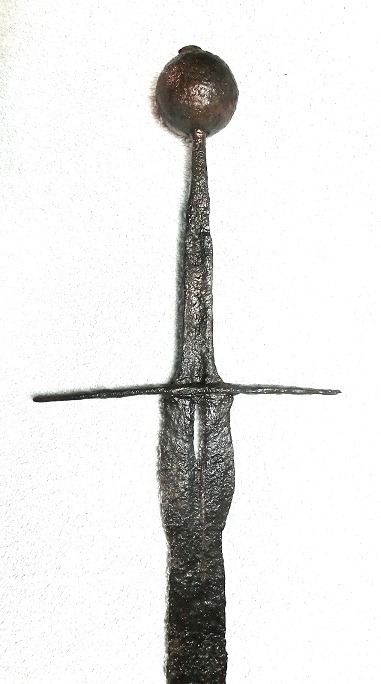
1
 Attachment: 45.97 KB
Attachment: 45.97 KB

2
 Attachment: 43.11 KB
Attachment: 43.11 KB
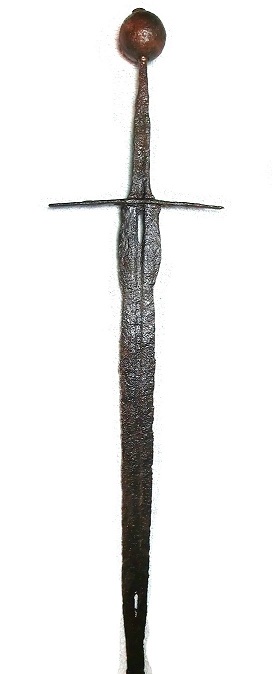
3
 Attachment: 113.5 KB
Attachment: 113.5 KB
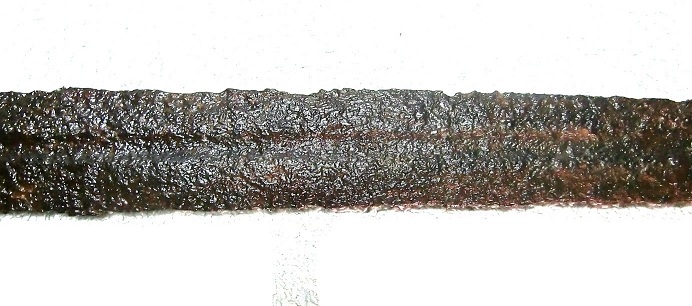
4
( made, photos was not correct size , sorry )

1

2

3

4
Last edited by Lorenzo Chinaglia on Wed 05 Dec, 2012 12:24 pm; edited 1 time in total
Wow, that's very interesting! Thanks for posting those!
any others help on ID Sean ? positive or negative comment are welcome ..... thank you
Well, it is hard to tell because blade edges are quite corroded. It might be a XII or a XVI. It might be second half of 13th or 14th century...
It might be tangential to the discussion but I believe there is a strong connection between the Byzantine sphere of influence and spherical and globular pommels.
http://www.orthodoxy-icons.com/uploads/posts/...rs-002.jpg
http://www.paradoxplace.com/Books/Covers%20Im...BAR450.jpg
http://www.levantia.com.au/military/pictures/paramerion.jpg
http://www.levantia.com.au/military/pictures/hilts.jpg
And appear to have been used from antiquity right through to the fall of Constantinople in one form or another.
http://www.orthodoxy-icons.com/uploads/posts/...rs-002.jpg
http://www.paradoxplace.com/Books/Covers%20Im...BAR450.jpg
http://www.levantia.com.au/military/pictures/paramerion.jpg
http://www.levantia.com.au/military/pictures/hilts.jpg
And appear to have been used from antiquity right through to the fall of Constantinople in one form or another.
thank you yes I agree abaut influence of bizantine culture .... here the detail of the pommel . Best Lorenzo
 Attachment: 55.7 KB
Attachment: 55.7 KB
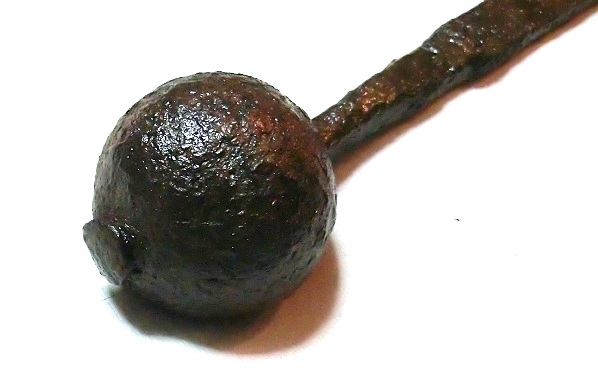
5

5
Here are a few more images of Type R pommels ... most of these have appeared on other threads here, but I thought it could be good to keep them all together.
First, Castillon/Dordogne single-hander, a fairly short blade length of 62.5 cm or ~24.6 inches, which would make the pommel about 4.33 cm or about 1.7 inches.
I'm currently working on an approximation of this piece ... but with a more standard blade length of around 31-32 inches, a 1.75 inch round pommel ends up looking out of proportion. So, I have a 2 incher on order ... we'll see what that does for balance and handling!
 Attachment: 20.21 KB
Attachment: 20.21 KB

First, Castillon/Dordogne single-hander, a fairly short blade length of 62.5 cm or ~24.6 inches, which would make the pommel about 4.33 cm or about 1.7 inches.
I'm currently working on an approximation of this piece ... but with a more standard blade length of around 31-32 inches, a 1.75 inch round pommel ends up looking out of proportion. So, I have a 2 incher on order ... we'll see what that does for balance and handling!

Last edited by Mark T on Mon 24 Feb, 2014 5:18 pm; edited 1 time in total
The sword displayed with the Henry XVIII tonlet armour at the RA:
 Attachment: 126.1 KB
Attachment: 126.1 KB

 Attachment: 44.26 KB
Attachment: 44.26 KB
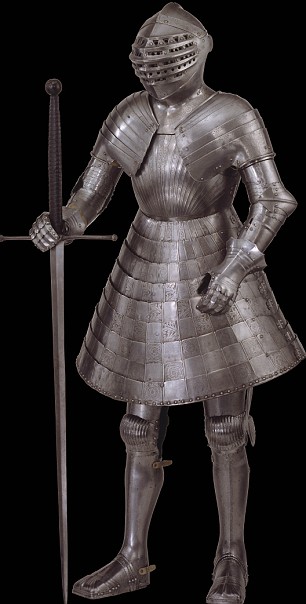
 Attachment: 137.6 KB
Attachment: 137.6 KB




This image has appeared here in a couple of threads, but the pommel is a nice example of the 'peeled mandarin' version of the Type R.
 Attachment: 183.82 KB
Attachment: 183.82 KB
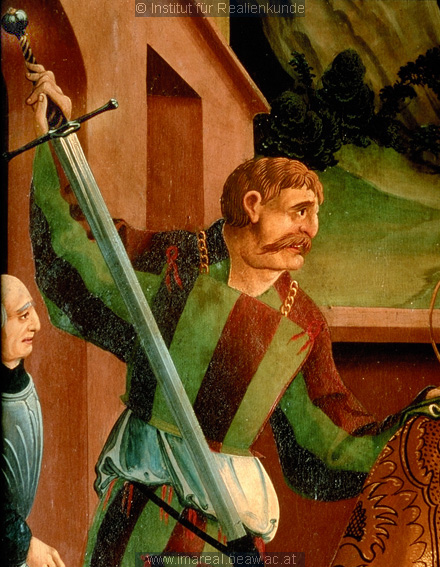

And here's an image from Osprey's 'Medieval Scandinavian armies 2', posted by Daniel Staberg in the Strange Two hander thread.
 Attachment: 120.57 KB
Attachment: 120.57 KB
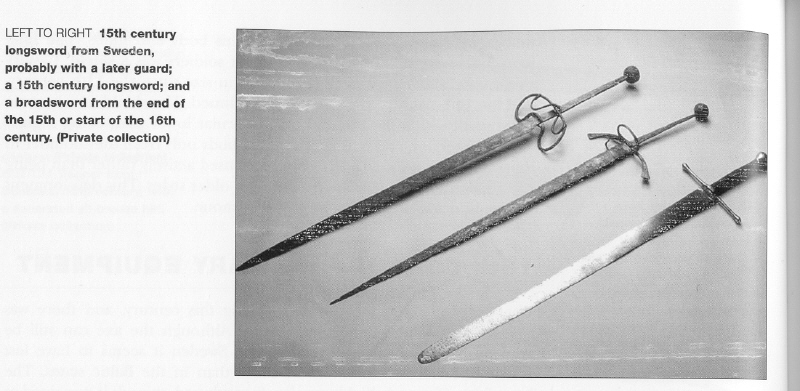

Page 1 of 3
You cannot post new topics in this forumYou cannot reply to topics in this forum
You cannot edit your posts in this forum
You cannot delete your posts in this forum
You cannot vote in polls in this forum
You cannot attach files in this forum
You can download files in this forum
All contents © Copyright 2003-2006 myArmoury.com — All rights reserved
Discussion forums powered by phpBB © The phpBB Group
Switch to the Full-featured Version of the forum
Discussion forums powered by phpBB © The phpBB Group
Switch to the Full-featured Version of the forum